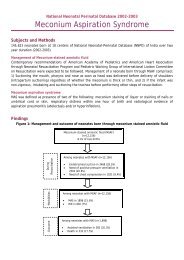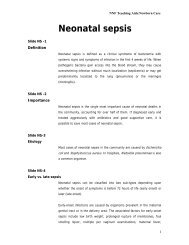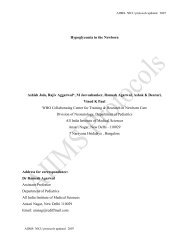Respiratory distress in - New Born Baby
Respiratory distress in - New Born Baby
Respiratory distress in - New Born Baby
Create successful ePaper yourself
Turn your PDF publications into a flip-book with our unique Google optimized e-Paper software.
Slide RD-18<br />
<strong>Respiratory</strong> <strong>distress</strong> syndrome (RDS)<br />
Slide RD-19<br />
Slide RD-20<br />
Pathogenesis<br />
Slide RD-21<br />
Predispos<strong>in</strong>g factors<br />
Slide RD-22<br />
Antenatal corticosteroids<br />
NNF Teach<strong>in</strong>g Aids:<strong>New</strong>born Care<br />
If a preterm baby has respiratory <strong>distress</strong> with<strong>in</strong> the first 6 hrs of birth and is<br />
cyanosed or needs oxygen to ma<strong>in</strong>ta<strong>in</strong> oxygen saturation the diagnosis is RDS<br />
unless proved otherwise. X-ray f<strong>in</strong>d<strong>in</strong>gs would be a reticulo-granular pattern <strong>in</strong><br />
mild disease and a "white out" picture <strong>in</strong> severe disease.<br />
X-ray show<strong>in</strong>g air bronchogram and hazy lung suggestive of HMD.<br />
The basic problem <strong>in</strong> a preterm baby with RDS is surfactant deficiency.<br />
Surfactant is needed to decrease alveolar surface tension and keep them open.<br />
In a preterm baby, absence of surfactant leads to alveolar collapse dur<strong>in</strong>g<br />
expiration. This affects gas exchange and the baby goes <strong>in</strong>to respiratory<br />
failure.<br />
Predispos<strong>in</strong>g factors <strong>in</strong>clude -prematurity, asphyxia and maternal diabetes.<br />
Prolonged rupture of membranes (PROM) and <strong>in</strong>trauter<strong>in</strong>e growth retardation<br />
are believed to enhance lung maturity. Drugs such as antenatal steroids<br />
enhance lung maturity and can prevent the neonate from develop<strong>in</strong>g RDS.<br />
Antenatal corticosteroid therapy is a simple and effective therapy that prevents<br />
RDS and saves neonatal lives. Antenatal steroids will prevent the occurrence<br />
and severity of RDS <strong>in</strong> preterm babies between 24 and 34 weeks of gestation.<br />
Optimal effect of antenatal steroids is seen if delivery occurs after 24 hours of<br />
the <strong>in</strong>itiation of therapy. Effect lasts for 7 days. Cases of preterm premature<br />
rupture of membrane (PPROM) at less than 32 weeks of gestation (<strong>in</strong> the<br />
absence of cl<strong>in</strong>ical chorioamnionitis), maternal hypertension and diabetes are<br />
not contra <strong>in</strong>dications for adm<strong>in</strong>ister<strong>in</strong>g antenatal steroids, if delivery is<br />
anticipated below 34 weeks of gestation. Dose recommended is Inj<br />
6








